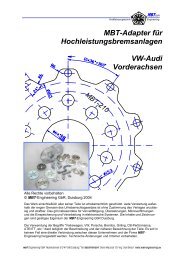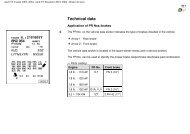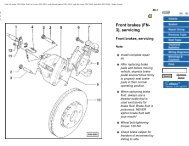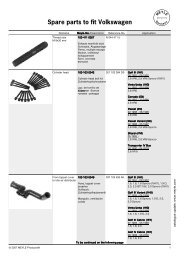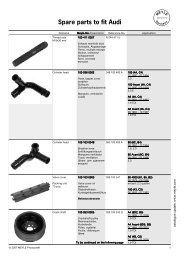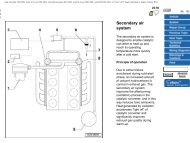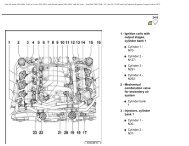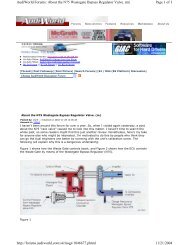VW MKII A2 MK2 Golf Jetta Fox Service Manual - VAGLinks.com
VW MKII A2 MK2 Golf Jetta Fox Service Manual - VAGLinks.com
VW MKII A2 MK2 Golf Jetta Fox Service Manual - VAGLinks.com
Create successful ePaper yourself
Turn your PDF publications into a flip-book with our unique Google optimized e-Paper software.
k) Never use an ohmmeter of the type<br />
incorporating a hand cranked generator<br />
for circuit or continuity testing.<br />
l) When carrying out welding operations on<br />
the vehicle using electric welding<br />
equipment, disconnect the battery and<br />
alternator.<br />
m) When fitting electrical accessories it is<br />
important that they are connected<br />
correctly, otherwise serious damage may<br />
result to the <strong>com</strong>ponents concerned.<br />
Items such as radios, tape recorders,<br />
electronic ignition systems, electronic<br />
tachometers, automatic dipping etc,<br />
should all be checked for correct polarity.<br />
2 Electrical fault-finding -<br />
general information<br />
1 A typical electrical circuit consists of an<br />
electrical <strong>com</strong>ponent, any switches, relays,<br />
motors, fuses, fusible links or circuit breakers<br />
related to that <strong>com</strong>ponent and the wiring and<br />
connectors that link the <strong>com</strong>ponent to both the<br />
battery and the chassis. To help you pinpoint<br />
an electrical circuit problem, wiring diagrams<br />
are included at the end of this Chapter.<br />
2 Before tackling any troublesome electrical<br />
circuit, first study the appropriate wiring<br />
diagram to get a <strong>com</strong>plete understanding of<br />
what <strong>com</strong>ponents are included in that<br />
individual circuit. Trouble spots, for instance,<br />
can be narrowed down by noting if other<br />
<strong>com</strong>ponents related to the circuit are<br />
operating properly. If several <strong>com</strong>ponents or<br />
circuits fail at one time, the problem is<br />
probably in a shared fuse or earth connection,<br />
as more than one circuit can be routed<br />
through the same connections.<br />
3 Electrical problems usually stem from<br />
simple causes, such as loose or corroded<br />
connections, a faulty earth, a blown fuse, a<br />
melted fusible link or a faulty relay. Visually<br />
inspect the condition of all fuses, wires and<br />
connections in a problem circuit before testing<br />
the <strong>com</strong>ponents. Use the diagrams to note<br />
which terminal connections will need to be<br />
checked in order to pinpoint the trouble spot.<br />
4 The basic tools needed for electrical faultfinding<br />
include a circuit tester or voltmeter (a<br />
12-volt bulb with a set of test leads can also<br />
be used), a continuity tester, a battery and set<br />
of test leads, and a jumper wire, preferably<br />
with a circuit breaker incorporated, which can<br />
be used to bypass electrical <strong>com</strong>ponents.<br />
Before attempting to locate a problem with<br />
test instruments, use the wiring diagram to<br />
decide where to make the connections.<br />
Voltage checks<br />
5 Voltage checks should be performed if a<br />
circuit is not functioning properly. Connect<br />
one lead of a circuit tester to either the<br />
negative battery terminal or a known good<br />
earth. Connect the other lead to a connector<br />
in the circuit being tested, preferably nearest<br />
to the battery or fuse. If the tester bulb lights,<br />
voltage is present, this means that the part of<br />
the circuit between the connector and the<br />
battery is problem-free. Continue checking<br />
the rest of the circuit in the same fashion.<br />
When you reach a point at which no voltage is<br />
present the problem lies between that point<br />
and the last test point with voltage. Most<br />
problems can be traced to a loose<br />
connection. Bear in mind that some circuits<br />
are live only when the ignition switch is<br />
switched to a particular position.<br />
Finding a short circuit<br />
6 One method of finding a short circuit is to<br />
remove the fuse and connect a test lamp or<br />
voltmeter to the fuse terminals with all the<br />
relevant electrical <strong>com</strong>ponents switched off.<br />
There should be no voltage present in the<br />
circuit. Move the wiring from side to side while<br />
watching the test lamp. If the bulb lights there<br />
is a short to earth somewhere in that area,<br />
probably where the insulation has rubbed<br />
through. The same test can be performed on<br />
each <strong>com</strong>ponent in the circuit, even a switch.<br />
Earth check<br />
7 To check whether a <strong>com</strong>ponent is properly<br />
earthed, disconnect the battery and connect<br />
one lead of a self-powered test lamp<br />
(sometimes known as a continuity tester) to a<br />
known good earth point. Connect the other<br />
lead to the wire or earth connection being<br />
tested. If the lamp lights, the earth is sound; if<br />
not, it must be rectified.<br />
8 The battery negative terminal is connected<br />
to earth ( the metal of the vehicle body) and<br />
most systems are wired so that they only<br />
receive a positive feed, the current returning<br />
via the metal of the vehicle’s body. This means<br />
that the <strong>com</strong>ponent mounting and the body<br />
form part of that circuit and loose or corroded<br />
mountings, therefore, can cause a range of<br />
electrical faults. Note that these may range<br />
from total failure of a circuit to a puzzling<br />
partial fault. In particular, lamps may shine<br />
dimly (especially when another circuit sharing<br />
the same earth point is in operation), motors<br />
(eg. wiper motors or the radiator cooling fan<br />
motor) may run slowly and the operation of<br />
one circuit may have an apparently unrelated<br />
effect on another. Note that a poor earth may<br />
not cause the circuit’s fuse to blow; in fact it<br />
may reduce the load on the fuse.<br />
9 If an earth connection is thought to be<br />
faulty, dismantle the connection and clean<br />
back to bare metal both the bodyshell and the<br />
wire terminal or the <strong>com</strong>ponent’s earth<br />
connection mating surface. Be careful to<br />
remove all traces of dirt and corrosion, then<br />
use a knife to trim away any paint, so that a<br />
clean metal-to-metal joint is made. On<br />
reassembly, tighten the joint fasteners<br />
securely; if a wire terminal is being refitted,<br />
use serrated washers between the terminal<br />
and the bodyshell to ensure a clean and<br />
secure connection. When the connection is<br />
remade, prevent the onset of corrosion in the<br />
1081 <strong>VW</strong> <strong>Golf</strong> & <strong>Jetta</strong><br />
Body electrical systems 12•3<br />
future by applying a coat of petroleum jelly or<br />
silicone-based grease or by spraying on (at<br />
regular intervals) a proprietary ignition sealer<br />
or a water dispersant lubricant.<br />
Continuity check<br />
10 A continuity check is necessary to<br />
determine if there are any breaks in a circuit.<br />
With the circuit switched off (ie no power in<br />
the circuit), a self-powered test lamp<br />
(sometimes known as a continuity tester) can<br />
be used to check the circuit. Connect the test<br />
leads to both ends of the circuit (or to the<br />
positive end and a good earth); if the test lamp<br />
lights, the circuit is passing current properly. If<br />
the lamp does not light, there is a break<br />
somewhere in the circuit.<br />
11 The same procedure can be used to test a<br />
switch, by connecting the continuity tester to<br />
the switch terminals. With the switch in the<br />
relevant position, the test lamp should light.<br />
Finding an open circuit<br />
12 When checking for possible open circuits,<br />
it is often difficult to locate them by sight<br />
because oxidation or terminal misalignment<br />
are hidden by the connectors; merely moving<br />
a connector on a sensor or in the wiring<br />
harness may correct the fault. Remember this<br />
if an open circuit is indicated when faultfinding<br />
in a circuit. Intermittent problems may<br />
also be caused by oxidised or loose<br />
connections.<br />
General<br />
13 Electrical fault-finding is simple if you<br />
keep in mind that all electrical circuits are<br />
basically electricity flowing from the battery,<br />
through the wires, switches, relays, fuses and<br />
fusible links to each electrical <strong>com</strong>ponent<br />
(light bulb, motor, etc.) and to earth, from<br />
where it is passed back to the battery. Any<br />
electrical problem is an interruption in the flow<br />
of electricity from the battery.<br />
3 Fuses and relays - location<br />
and renewal 1<br />
1 The fuses and relays are located under the<br />
facia panel on the right-hand side (see<br />
illustration).<br />
3.1 Removing fuse/relay unit cover<br />
12



